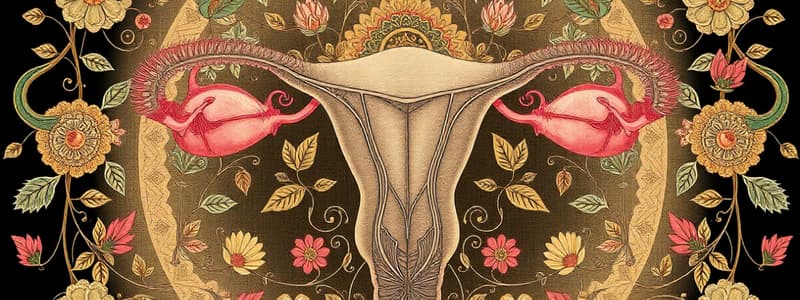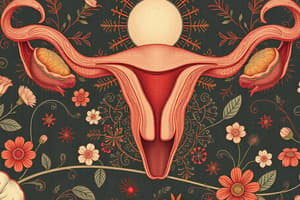Podcast
Questions and Answers
Which of these organs is responsible for the production of sperm cells?
Which of these organs is responsible for the production of sperm cells?
- Vas deferens
- Scrotum
- Epididymis
- Testes (correct)
Which of the following hormones is responsible for triggering the release of the egg during ovulation?
Which of the following hormones is responsible for triggering the release of the egg during ovulation?
- Progesterone
- FSH
- Estrogen
- LH (correct)
The urethra is a tube that transports both urine and sperm cells.
The urethra is a tube that transports both urine and sperm cells.
True (A)
The follicular phase of the menstrual cycle begins on the day of ovulation and ends with the start of menstruation.
The follicular phase of the menstrual cycle begins on the day of ovulation and ends with the start of menstruation.
What is the function of the seminal vesicle?
What is the function of the seminal vesicle?
The ______ gland secretes an alkaline fluid that neutralizes acidic urine in the urethra.
The ______ gland secretes an alkaline fluid that neutralizes acidic urine in the urethra.
What are two symptoms that may occur during the luteal phase of the menstrual cycle?
What are two symptoms that may occur during the luteal phase of the menstrual cycle?
The ______ system is responsible for producing and regulating hormones throughout the body.
The ______ system is responsible for producing and regulating hormones throughout the body.
Match the following male reproductive structures with their functions:
Match the following male reproductive structures with their functions:
Match the following glands with their corresponding secretions:
Match the following glands with their corresponding secretions:
During which stage of the ovarian cycle does the follicle burst, leading to ovulation?
During which stage of the ovarian cycle does the follicle burst, leading to ovulation?
The vas deferens is the site where sperm cells mature.
The vas deferens is the site where sperm cells mature.
The hormone _____, produced by the ovaries, triggers development in a female.
The hormone _____, produced by the ovaries, triggers development in a female.
Which of the following is NOT part of the endocrine system?
Which of the following is NOT part of the endocrine system?
What is the name of the narrow opening of the uterus that serves as the birth canal and channels blood discharge?
What is the name of the narrow opening of the uterus that serves as the birth canal and channels blood discharge?
The hypothalamus is responsible for producing hormones that regulate other glands in the body.
The hypothalamus is responsible for producing hormones that regulate other glands in the body.
Match the following structures with their corresponding functions in the female reproductive system:
Match the following structures with their corresponding functions in the female reproductive system:
What is the approximate lifespan of an unfertilized egg cell after being released from the ovary?
What is the approximate lifespan of an unfertilized egg cell after being released from the ovary?
What is the main function of the thyroid gland?
What is the main function of the thyroid gland?
The ______ gland is located at the base of the brain and acts as a link between the nervous system and the endocrine system.
The ______ gland is located at the base of the brain and acts as a link between the nervous system and the endocrine system.
The anterior pituitary gland releases both FSH and LH during the luteal phase of the ovarian cycle.
The anterior pituitary gland releases both FSH and LH during the luteal phase of the ovarian cycle.
What is the name of the structure that forms from the ruptured follicle after ovulation, and produces progesterone?
What is the name of the structure that forms from the ruptured follicle after ovulation, and produces progesterone?
Match the endocrine gland with its primary hormone:
Match the endocrine gland with its primary hormone:
Which hormone is primarily responsible for regulating blood calcium levels?
Which hormone is primarily responsible for regulating blood calcium levels?
The adrenal cortex secretes hormones that primarily influence the body's response to stress.
The adrenal cortex secretes hormones that primarily influence the body's response to stress.
What is the role of the pineal gland?
What is the role of the pineal gland?
Which of the following is NOT a function of the nervous system?
Which of the following is NOT a function of the nervous system?
Sensory neurons carry impulses from the brain to the muscles and glands.
Sensory neurons carry impulses from the brain to the muscles and glands.
What is the basic functional unit of the nervous system?
What is the basic functional unit of the nervous system?
A ______ is a response to a stimulus without the need for conscious thought.
A ______ is a response to a stimulus without the need for conscious thought.
Match the following types of neurons with their functions:
Match the following types of neurons with their functions:
Flashcards
Sperm and Egg Cells
Sperm and Egg Cells
Reproductive cells that unify to form a zygote, each containing 23 chromosomes.
Zygote
Zygote
A cell formed by the union of a sperm and an egg, contains 46 chromosomes (diploid).
Testes
Testes
The main organ where sperm cell formation occurs, located in the scrotum.
Luteinizing Hormone (LH)
Luteinizing Hormone (LH)
Signup and view all the flashcards
Seminal Vesicle
Seminal Vesicle
Signup and view all the flashcards
Menstrual Cycle
Menstrual Cycle
Signup and view all the flashcards
Follicular Phase
Follicular Phase
Signup and view all the flashcards
Ovulation Phase
Ovulation Phase
Signup and view all the flashcards
Luteal Phase
Luteal Phase
Signup and view all the flashcards
Hormones
Hormones
Signup and view all the flashcards
Hypothalamus
Hypothalamus
Signup and view all the flashcards
Sperm cell maturation
Sperm cell maturation
Signup and view all the flashcards
Pituitary Gland
Pituitary Gland
Signup and view all the flashcards
Vas deferens
Vas deferens
Signup and view all the flashcards
Ovaries
Ovaries
Signup and view all the flashcards
Thyroid Gland
Thyroid Gland
Signup and view all the flashcards
Parathyroid Gland
Parathyroid Gland
Signup and view all the flashcards
Thymus
Thymus
Signup and view all the flashcards
Ovulation
Ovulation
Signup and view all the flashcards
Adrenal Glands
Adrenal Glands
Signup and view all the flashcards
Pancreas
Pancreas
Signup and view all the flashcards
Corpus luteum
Corpus luteum
Signup and view all the flashcards
Pineal Gland
Pineal Gland
Signup and view all the flashcards
Nervous System
Nervous System
Signup and view all the flashcards
Endocrine System
Endocrine System
Signup and view all the flashcards
Neurons
Neurons
Signup and view all the flashcards
Sensory Neurons
Sensory Neurons
Signup and view all the flashcards
Reflex
Reflex
Signup and view all the flashcards
Study Notes
Human Reproduction
- A single cell (zygote) forms from the union of an egg and sperm cell.
- Each sex cell contains 23 chromosomes (haploid).
- A zygote contains 46 chromosomes (diploid).
Male Reproductive System
- Testes: The primary site of sperm formation, located inside the scrotum.
- Scrotum: A protective sac of skin.
- Epididymis: A coiled tube where sperm mature.
- Vas Deferens: Transports mature sperm cells.
- Urethra: A larger tube through which sperm and urine exit the body.
- Penis: The male sex organ used for both urine and sperm release.
- Seminal Vesicles: Secrete 60% of the semen volume, providing energy.
- Prostate Glands: Produce an alkaline fluid that neutralizes acidic urine in the female reproductive tract.
- Bulbourethral Glands: Produce an alkaline fluid.
Male Hormones and Their Functions
- Luteinizing Hormone (LH): Stimulates testosterone secretion.
- Follicle-Stimulating Hormone (FSH): Stimulates sperm production along with testosterone.
- Testosterone: Essential for male sex organ development and growth.
Sperm Cells
- Tail: Responsible for sperm movement.
- Head: Contains the nucleus.
- Mitochondria: Provides energy.
- Sperm cells mature in the epididymis and travel through the vas deferens.
- Sperm cells exit the body through the urethra.
Female Reproductive System
- Ovaries: Produce eggs (ova).
- Fallopian Tubes: Where fertilization occurs.
- Uterus: Where a fertilized egg develops.
- Cervix: The opening of the uterus.
- Vagina: The birth canal.
- Vulva: The external female genitalia.
Ovarian Cycle
- The ovary prepares the egg for maturation (ovulation).
- Ovulation is the release of an egg from the ovary (every 28 days approximately).
- Two stages: Follicular and Luteal phase.
- Follicular phase: Anterior pituitary releases FSH and LH stimulating follicle growth and causing the release of estrogen.
- Luteal phase: The ruptured follicle becomes the corpus luteum. That produces progesterone.
- Without fertilization the corpus luteum atrophies.
Menstrual Cycle
- Cycle where the uterus prepares for pregnancy.
- Four phases: Menstrual, follicular, ovulation, and luteal phase.
Human Body Regulation
- Positive feedback: Amplifies stimulus until process is complete (less common);
- Negative feedback: Reduces the stimulus, bringing body back to homeostasis;
- Hormones: Chemical messengers that carry instructions.
- The Endocrine system is responsible for regulating all the bodily functions.
Major Endocrine Glands
- Pituitary Gland: Regulates growth and reproductive function.
- Thyroid Gland: Secretes hormones regulating metabolism.
- Parathyroid Gland: Regulates blood calcium levels.
- Thymus: Produces T cells for immunity.
- Adrenal Gland: Produces adrenaline and other hormones.
- Pancreas: Produces insulin and glucagon regulating blood sugar levels.
Other Notes
- Female Reproductive Cycle Notes: Egg cells mature in follicles in the ovary (up to 500 mature). Egg cells can live for a short time.
- Nervous System: Quickly gathers information (from inside and outside the body). Sends this information to the muscles, glands, and organs. Transmits information through the nervous pathways.
- Endocrine System: Slower response but produces longer-lasting effects.
Studying That Suits You
Use AI to generate personalized quizzes and flashcards to suit your learning preferences.




